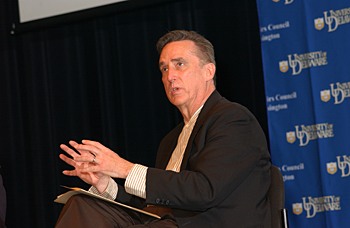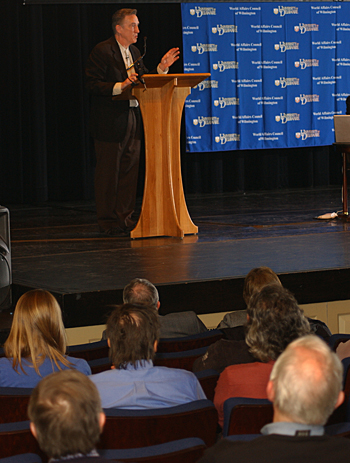
“It's not simply about preserving the American way of life," Bryne, Distinguished Professor of Public Policy at UD, said. "If the American way of life threatens other forms of life, we need to think about whether there is something wrong and something that needs to be fixed with the American way of life.”
Byrne's lecture, “New Politics for New Weather,” was part of UD's 2008 Global Agenda series, “Boiling Point: International Politics of Climate Change.”
In his talk, Byrne focused on three popular ideas for controlling the amount of pollution produced by America and discussed some of the problems that arise from these proposed solutions. He also offered his own take on what needs to be done to reduce the nation's contribution to global warming.
First Byrne addressed proposals for creating a carbon store to take up the excess carbon that the American lifestyle produces. Carbon sequestration proposals are based on the premise, he said, that “The American lifestyle [should] basically remain the American lifestyle but for us to build a carbon store to take up the excess carbon, and basically ask biology to solve the problem.”
After explaining that the carbon store would be created through vegetation, Byrne showed a map of the United States and the size of the carbon store that would need to be created to sequester the excess carbon created by current lifestyles. The map showed that the carbon store would have to cover roughly one-third of the United States and displace 24 million people to handle the excess carbon.
The second proposed global warming solution Byrne discussed was nuclear power. “We can do a lot with a lot of different kinds of technology, but it's not clear that we're going to be able to solve the problem at this time by simply taking out one kind of power plant and replacing it with another,” he said.
Byrne said a third proposed solution, using renewable energy sources, is very popular with American environmentalists because it would “leave the demand for energy basically as it is, but replace the exhaust chemistry in the energy system by changing out the fossil fuels and replacing them with renewables.”Byrne stressed that he was not arguing against the use of renewable energy--pointing out that he spent the better part of his professional life advocating the use of renewable energy.
“In the U.S. case, we are going to need to do a lot more than simply change out one type of energy system with another. There is no way for the United States to participate in a process of solving the problem of climate change unless we solve not simply the supply side but also the demand side,” he said.
“There has to be changes in the way in which we think about energy. We are at a significant point in the history of modern life....We need to think carefully, we need to think significantly and, of course, we need to act.”
Article by Adam Thomas
Photos by Duane Perry

